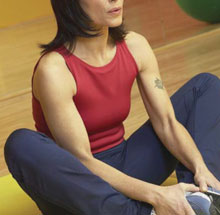Never Underestimate the Value of Stretching
 Lack of flexibility not only slows athletic progress but also can lead to injury. This can derail even the most well-thought-out fitness routine. When you were a baby, you were so flexible that you could probably put your head in between your knees. When you were a teenager, you could probably do a complete backbend. However, as an adult, you probably would not even think of doing a complete backbend. As you age, both your muscles and tendons lose their flexibility and if you don’t exercise regularly, your muscles flex even less, getting stiffer with time.
Lack of flexibility not only slows athletic progress but also can lead to injury. This can derail even the most well-thought-out fitness routine. When you were a baby, you were so flexible that you could probably put your head in between your knees. When you were a teenager, you could probably do a complete backbend. However, as an adult, you probably would not even think of doing a complete backbend. As you age, both your muscles and tendons lose their flexibility and if you don’t exercise regularly, your muscles flex even less, getting stiffer with time.
Aside from the aging process, your habits and daily activities can also play a role in shortening your muscles and tendons. Even the shoes you wear affect your flexibility. For example, when women wear high heels, the hamstrings and calves become shortened. This is typically apparent when trying to do a leg curl or squat after a full day at work in heels. The shortened muscles may not perform willingly and trying to push a shortened muscle or tendon through too much range of motion can result in pain or an injury, such as tendonitis.
Ironically, lifestyle is not the only factor that affects flexibility, exercise does as well. Weight training and weight-bearing activity like jogging contract muscles repeatedly, shortening the muscles and tendons involved. So it’s important to stretch out your muscles before, as well as after you use them. If you do so, not only will your muscles and tendons retain their elasticity but also they will be able to get even stronger.
Nine Stretching Exercises
Start Stretching!
Here are some stretching exercises developed by the American Academy of Orthopaedic Surgeons that all athletes can perform before participating in any athletic activity. Take your time when doing the exercises and perform each one carefully; speed is not important. Once you have learned the routine, the entire program should take no more than 10 minutes. Proper warm up is essential before attempting this or any exercise routine. Good examples of warm-up activities include slowly running I place and walking for a few minutes.
- Seat Straddle Lotus
Sit down; place soles of feet together and drop knees toward the floor. Place forearms on inside of knees and push knees to the ground. Then lean forward bringing the chin to the feet. Repeat three to six times. - Seat Side Straddle
Sit with legs spread apart; place both hands on left ankle. Bring chin to knee while keeping the left leg straight. Hold for five seconds. Repeat three to six times and then repeat on opposite leg. - Seat Stretch
Sit with legs together, feet flexed, hands on ankles. Bring chin to knees. Hold for five seconds. Repeat three to six times. - Lying Quad Stretch
Lie on back with one leg straight, the other leg with hip turned in, knee bent and foot turned out. Press bent knee to floor. Hold for five seconds. Repeat three to six times and then repeat on opposite leg. - Knees to Chest
Lie on back with knees bent in toward chest. Grasp tops of knees and rotate them out toward the armpits, rocking gently. Hold for five seconds. Repeat three to six times. - Forward Lunges
Kneel on left leg; place right leg forward at right angle. Lunge forward and keep the back straight. The stretch should be felt in the left groin. Hold for five seconds. Repeat three to six times and repeat on opposite leg. - Side Lunges
Stand with legs apart; bend the left knee while leaning toward the left. Keep the back straight and the right leg straight. Hold for five seconds. Repeat three to six times and repeat on opposite leg. - Cross-Over
Stand with legs crossed; keep feet close together and legs straight. Touch toes and hold for five seconds. Repeat three to six times and repeat on opposite leg. - Standing Quad Stretch
Stand supported with hand against wall and pull foot to buttocks. Hold five seconds. Repeat three to six times and repeat on opposite leg.
The information contained in this article is intended to educate. Do not substitute it for the advice of a qualified health care professional. Reader discretion is advised.
